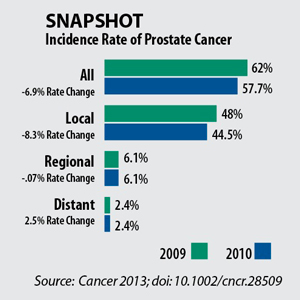Mortality Rates for Four Major Cancers in Decline
The Annual Report to the Nation on the Status of Cancer shows that death rates for the four most common cancers—lung, prostate, breast, and colorectal—have continued to decline, accounting for two-thirds of the overall reduction in cancer death rates between 2001 and 2010. Over the same period, however, death rates increased for liver and pancreas cancer in both women and men. Death rates for melanoma and soft tissue cancer also rose in men, while women had higher mortality rates of uterine cancer.
The authors observed a 6.9% decline in prostate cancer incidence between 2009–2010, which they attributed to a decrease in prostate-specific antigen (PSA) testing. The change in PSA testing practices also was reflected in the stage at which prostate cancer was detected. While the incidence of localized cases declined and regional cases held steady, the incidence of distant cases rose.

The Annual Report, a collaboration of the National Cancer Institute, the American Cancer Society, the Centers for Disease Control and Prevention, and the North American Association of Central Cancer Registries, each year updates cancer incidence and mortality rates for the U.S. with in-depth analysis on special topics. This year, the authors looked at how 16 comorbid conditions, such as diabetes and dementia, affect the probability of dying from the four most common cancers. By comparing cancer registry data with Medicare claims data they found that nearly one-third of cancer patients had comorbidities, similar to the cancer-free population.
Lung cancer patients had the highest prevalence of comorbidities, 52.9%, while those with prostate cancer had the least at 30.5%. Stage of diagnosis, age, and comorbidity levels all influenced survival rates. For example, in women ages 66–74 with early stage breast cancer, the probability of death for low or moderate comorbidity levels was almost double that of women with no comorbidities.